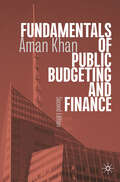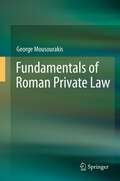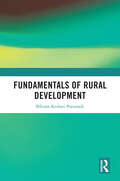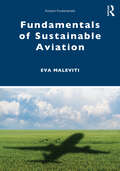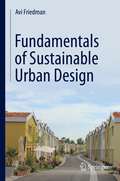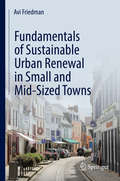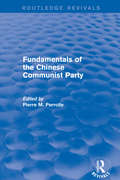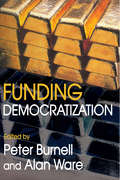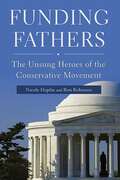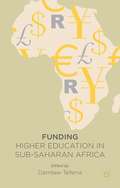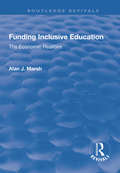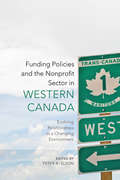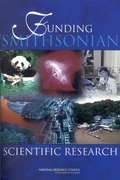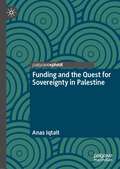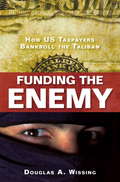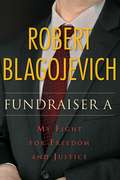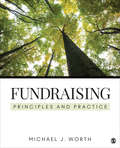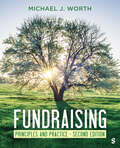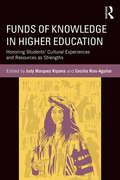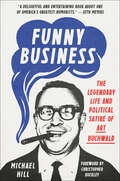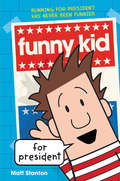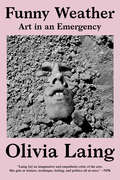- Table View
- List View
Fundamentals of Public Budgeting and Finance
by Aman KhanBudgeting is arguably the single most important function in government. Every year governments spend considerable sums on expenditure programs and activities, as well as time preparing and executing the budget. It is therefore crucial that anyone interested in a career in public administration has a fundamental grasp of these basics. This second edition textbook integrates theory and practice of public budgeting into a single volume. The first part introduces the background to budgeting, focusing especially on taxation, government expenditure and revenue. The second part focuses on budgeting basics, in particular operating and capital budget. The final part deals with budgeting tools, especially those related to capital rationing, budget forecasting, and analyzing government revenue and expenditure. Written in a concise and easy to understand manner, this book captures the multidimensional nature of public budgeting that both students and practitioners will find useful. This second edition has been fully revised and updated, as well as expanded to include new material and exercises. It will appeal to all those studying public administration, financial management and public budgeting.
Fundamentals of Roman Private Law
by George MousourakisRoman law forms a vital part of the intellectual background of many legal systems currently in force in Continental Europe, Latin America, East Asia and other parts of the world. Knowledge of Roman law, therefore, constitutes an essential component of a sound legal education as well as the education of the student of history. This book begins with a historical introduction, which traces the evolution of Roman law from the earliest period of Roman history up to and including Justinian's codification in the sixth century AD. Then follows an exposition of the principal institutions of Roman private law: the body of rules and principles relating to individuals in Roman society and regulating their personal and proprietary relationships. In this part of the book special attention is given to the Roman law of things, which forged the foundations for much of the modern law of property and obligations in European legal systems. Combining a law specialist's informed perspective with a historical and cultural focus, the book provides an accessible source of reference for students and researchers in many diverse fields of legal and historical learning.
Fundamentals of Rural Development
by Bikram Keshari PattanaikThe book expounds on the functioning of rural development as well as the practical problems encountered in the formulation of rural development policies and programmes. It provides an exhaustive account of the various sectors and actors of rural development and presents it as a multidimensional concept by documenting its different components. It also details the paradigms and strategies of rural development adopted by developed and developing countries of the world.This volume deals with rural cooperatives and livelihood in order to understand how the development process can be self-sustained and sustainable, following the vocal for local mantra. It also extensively discusses rural basic needs, poverty, employment, the role of Panchayati Raj institutions, the corporate sector, NGOs, peoples’ participation, and capacity building in rural development.This book will be useful to undergraduate and postgraduate students, researchers, and teachers of development studies, economics, sociology, political science, and public administration. It will be useful for the administrators and development administration officials of state and central government, planners, policymakers, and people working in NGOs and corporate sector functionaries dealing with corporate social responsibilities especially those handling developmental issues and challenges.
Fundamentals of Sustainable Aviation (Aviation Fundamentals)
by Eva MalevitiFundamentals of Sustainable Aviation is the first textbook to survey the critical field of sustainability within the aviation industry. Taking a systems thinking approach, it presents the foundational principles of sustainability and methodically applies them to different aviation sectors. Opening with the basics of sustainability, emphasising the Sustainable Development Goals, the book then considers the environmental, economic and social dimensions of aviation. The following chapters apply these insights to aviation design, supply chains, operations, maintenance and facilities. The final chapter examines the concept of resilience in sustainable aviation. Overall, the textbook shows how future sustainability can be achieved by making better decisions today. Students are supported with international case studies throughout the book. Slides, test questions and a teaching manual are available for instructors. This textbook is the ideal resource for courses on sustainable aviation globally and will also be of great interest to professionals in the field.
Fundamentals of Sustainable Aviation (ISSN)
by Eva MalevitiFundamentals of Sustainable Aviation is the first textbook to survey the critical field of sustainability within the aviation industry. Taking a systems thinking approach, it presents the foundational principles of sustainability and methodically applies them to different aviation sectors.Opening with the basics of sustainability, emphasising the Sustainable Development Goals, the book then considers the environmental, economic and social dimensions of aviation. The following chapters apply these insights to aviation design, supply chains, operations, maintenance and facilities. The final chapter examines the concept of resilience in sustainable aviation. Overall, the textbook shows how future sustainability can be achieved by making better decisions today.Students are supported with international case studies throughout the book. Slides, test questions and a teaching manual are available for instructors. This textbook is the ideal resource for courses on sustainable aviation globally and will also be of great interest to professionals in the field.
Fundamentals of Sustainable Urban Design
by Avi FriedmanThis book begins with an introduction describing current societal transformations that merit new urban designs, including depletion of non-renewable natural resources, elevated levels of greenhouse gas emissions, large numbers of aging “Baby Boomers,” and climate change. Dr. Friedman then examines these challenges through thirty chapters of interest to urban designers, architects, civil and construction engineers, and town planners. Each of these topics represents an aspect of urban design and describes an innovative solution and offers a detailed description of underlying principles. The highly illustrated text presents innovative urban design strategies based on sustainable principles. Integrated with each chapter are several international case studies illustrating design implementations.
Fundamentals of Sustainable Urban Renewal in Small and Mid-Sized Towns
by Avi FriedmanThe book introduces challenges affecting smaller urban communities with fewer than 50,000 inhabitants and offers urban planning and building/architectural strategies to strengthen their city centers. It divides urban renewal of small towns into sub-components such as environmental challenges, demographic trends, economic changes and cultural aspects, and aging infrastructure. In each, context is established, and principles are outlined and illustrated. Topics include urban form, mobility and connectivity, infill neighborhoods design, wealth generation, and promotion of local culture and well‐being. Reinforced with detailed case studies, Fundamentals of Sustainable Urban Renewal in Small and Mid‐Sized Towns is an ideal resource for municipal planners, architects, civil engineers, and policy makers.
Fundamentals of the Chinese Communist Party (Routledge Revivals)
by Pierre M. PerrolleThis title was first published in 1976. From 1966 to 1969 the large-scale political turmoil and intense conflicts of the Cultural Revolution in China shattered notions of institutional permanence and unshakable legitimacy that many analysts had come to associate with the Communist Party of China, which had ruled the People's Republic for over fifteen years. Just as the high-level bureaucrats of the Party were shaken from their complacency, it seemed for a time, from the outside, as though it could no longer be taken for granted that the Communist Party would continue to provide the institutional core for political leadership in China. Fundamentals of the Party (Tang ti chi-ch'u chih-shih), which we are translating and publishing here as Fundamentals of the Chinese Communist Party, was published by the Shanghai People's Press in 1974 and constitutes an important source of the type needed to study the revival of the Party.
Funding Democratization (Perspectives On Democratization Ser.)
by Alan Ware Peter BurnellDemocracy is a fine political system, but an expensive economic venture. Political parties and election campaigns cost money. Where does the money come from and at what sacrifice? Issues connected with political finance are significant but often neglected aspects of the process of democratization. Funding Democratization examines how money and politics interact in emerging democracies. The contributors investigate the funding of political parties in early North America, financial uncertainties of party formation in European countries, funding of democratization in new democracies, and the influence of funding on contenders for power. They also address the nature of political competition in countries that are seeking to embrace, often for the first time, the rules of democracy. They question in what ways politicians can help make democracy affordable. The volume compares important democratizing countries, such as Russia, Brazil, South Africa, Spain, and the regions of East Asia and East/Central Europe. It also investigates the lessons that emerging democracies can learn from the history of political finance in today's more established democracies. Funding Democratization will be of interest to political scientists and specialists in international social and political development.
Funding Fathers: The Unsung Heroes of the Conservative Movement
by Ron Robinson Nicole HoplinMoney changes everything, especially in politics. Politicians, think tanks, and political parties would not be where they are without monetary gifts. Yet, when it comes to celebrating donors, the media often praise liberals for their selfless giving and criticize conservatives for their selfish hoarding. But Ron Robinson and Nicole Hoplin, leaders of Young America's Foundation, set the record straight in Funding Fathers: The Unsung Heroes of the Conservative Movement. Part historical account of the conservative movement and part exposé about political philanthropy, Funding Fathers busts the myth that conservatives donate less money than democrats and exposes how the media, liberal organizations, and even conservatives perpetuate this lie. In Funding Fathers, Robinson and Hoplin reveal:* How conservative donors have had as much influence on the conservative movement as people like Ronald Reagan and William F. Buckley Jr.* Why anonymous donations can do more harm than good to the conservative movement* How donations benefiting conservative ideas are often misappropriated at universities across the U.S.* How conservative politicians and organizations use donations more efficiently than liberalsMoney matters. But it is not the size of the donation that counts, it is the impact it makes. Funding Fathers shows how the unsung heroes of the conservative movement have not only influenced the past, but also how they continue to shape the future.
Funding Higher Education In Sub-saharan Africa
by Damtew TeferraVirtually all countries in the world are struggling to provide the necessary resources to Higher Education. The challenges are particularly complex for economically poor countries in Africa, which have recorded massive expansion in the past decade. This book analyzes the state of funding and financing higher education in Sub-Saharan Africa.
Funding Inclusive Education: The Economic Realities (Monitoring Change In Education Ser.)
by Alan J. MarshThis title was first published in 2003.Funding for pupils with special educational needs has created resource management difficulties for schools and budgetary control problems for LEAs. Special educational needs is a frequent area of LEA overspending. These issues are particularly important as the development of inclusion and raising attainment for all pupils are key Government priorities. Many LEAs are now considering revisions of their funding formulae for additional and special educational needs during Best Value Reviews and Fair Funding consultations. This stimulating and accessible book examines the policy context for formula funding and the design and accountability issues for the construction of a revised formula. One of the central themes is the idea that a funding formula should be viewed as a key instrument of policy to assist in delivering specific inclusive policy objectives to meet the additional and special educational needs of pupils.
Funding Policies and the Nonprofit Sector in Western Canada: Evolving Relationships in a Changing Environment
by Peter R. ElsonFunding Policies and the Nonprofit Sector in Western Canada offers a detailed yet accessible account of nonprofit funding policies in a region characterized by fiscal conservatism, a cyclical resource-based economy, and a growing share of Canada's population and GDP.The chapters in this collection offer compelling and candid analyses of the realities of nonprofit funding in Western Canada. Each combines practical insights with academic rigour, providing critical historical context and an up-to-date profile of funding for services. For each province, a leading practitioner has provided an insider perspective into a specific regime or organization: nonprofit housing in British Columbia; the politics of social policy in Alberta; sport, culture, and recreation, and lottery funds in Saskatchewan; and community economic development in Manitoba.Written by leading researchers and practitioners, Funding Policies and the Nonprofit Sector in Western Canada offers a solid foundation on which policymakers, scholars, and practitioners alike can examine the challenges and opportunities of the contemporary funding environment.
Funding Smithsonian Scientific Research
by Committee on Smithsonian Scientific ResearchThis book assesses whether the Smithsonian Institution should continue to receive direct federal appropriations for its scientific research programs or if this funding should be transferred to a peer-reviewed program open to all researchers in another agency. The report concludes that the National Museum of Natural History, the National Zoological Park, and the Smithsonian Center for Materials Research and Education in Suitland should remain exempt from having to compete for federal research dollars because they make unique contributions to the scientific and museum communities. Three other Smithsonian research programs should continue to receive federal funding since they are performing science of the highest quality and already compete for much of their government research money.
Funding and the Quest for Sovereignty in Palestine
by Anas IqtaitThis book explores the political economy of governance in Palestine. It makes a unique contribution to studies of governance and political economy using the Palestinian Authority (PA) as a case study, introducing and developing the concept of ‘dual rentierism’. The author uses primary research to chart the evolution of the fiscal sociology of the PA and explore how it has shaped the PA’s economic policies and the state–society relationship in the Palestinian Territories. The book adopts a critical political economy approach, making the case that external sources of PA income represent political rents that need to be disaggregated and studied concurrently. It further focuses on the drivers and constraints that have shaped the PA’s policy development and state-building associated with its dependence on external revenues. Ultimately, the book elaborates on how the need for fiscal survivability has thwarted the Palestinian quest for statehood.
Funding the Enemy
by Douglas A. WissingWith the vague intention of winning hearts and minds in Afghanistan, the US government has mismanaged billions of development and logistics dollars, bolstered the drug trade, and dumped untold millions into Taliban hands. That is the sobering message of this scathing critique of our war effort in Afghanistan. According to this book, America has already lost the war. While conducting extensive research and fieldwork in Afghanistan's war zones, a drumbeat of off-the-record and offhand remarks pointed the author to one conclusion: "We blew it." The sentiment was even blazoned across a US military fortification, as the author saw at Forward Operating Base Mehtar Lam in insurgency-wracked Laghman Province: "I glanced over at a concrete blast barrier while waiting for a helicopter," Wissing says. "Someone had spray-painted in jagged letters: 'The GAME. You Lost It.'" The author's vivid narrative takes the reader down to ground level in frontline Afghanistan. It draws on the voices of hundreds of combat soldiers, ordinary Afghans, private contractors, aid workers, international consultants, and government officials. From these contacts it became glaringly clear, as the author details, that American taxpayer dollars have been flowing into Taliban coffers, courtesy of scandalously mismanaged US development and counterinsurgency programs, with calamitous military and social consequences. This is the first book to detail the toxic embrace of American policymakers and careerists, Afghan kleptocrats, and the opportunistic Taliban. The result? US taxpayers have been footing the bill for both sides of a disastrous Afghanistan war.
Fundraiser A: My Fight for Freedom and Justice
by Robert BlagojevichMost people will recognize the name Robert Blagojevich as the brother of ill-fated Illinois governor Rod Blagojevich. But many don't know why Robert came to work for his brother or how he came to be named as a defendant in the criminal trial accusing Rod of attempting to sell Barack Obama's former Senate seat to the highest bidder after the presidential election of 2008. Now, Robert offers a brutally honest inside look at what it is like to face the full force and power of the federal government and maintain innocence in a high-profile criminal case. By the time United States of America vs. Rod Blagojevich and Robert Blagojevich was over, one of the most renowned prosecutors in America, Patrick Fitzgerald, had brought down a governor of Illinois for the second time in five years. An investigation that would unseat one of the unindicted "co-conspirators" in the case, Congressman Jesse Jackson Jr., had begun. And the integrity of President Obama, US Senator Roland Burris, and Chicago Mayor Rahm Emanuel had been called into question. For the last four months of 2008, Robert was, at his brother's request, the head of Rod's fundraising operation, Friends of Blagojevich. Rod and Robert had taken very different career paths and had drifted apart by middle age. But when Rod asked Robert to help him fundraise—because he couldn't trust anyone else in the role—Robert agreed, honoring his parents' wish that the brothers help one another when needed. In the rough-and-tumble world of Chicago-style politics, operating on an ethical level was not easy, as this telling memoir demonstrates. Robert often had to tell potential donors that there was no quid pro quo for a contribution: giving money did not result in state contracts and certainly didn't result in an appointment to fill a vacant Senate seat. Fundraiser A is a criminal defendant's gripping account of how he rose to the biggest challenge of his life and beat the odds of a 96 percent Department of Justice conviction rate to walk away with his freedom. It offers not only a previously untold story of a fascinating trial with well-known, colorful characters that captured the attention of the nation, but also a look at a universal relationship—brothers—as well as the theme of a David ordinary citizen facing the Goliath federal government. Those who enjoy legal thrillers, political dramas, family sagas, and all things Chicago will be especially interested in this memoir.
Fundraising: Principles and Practice
by Michael J. WorthFundraising: Principles and Practice provides readers with a comprehensive introduction to fundraising. Taking a balanced perspective, bestselling author Michael J. Worth offers insights on the practical application of relevant theory. The text is designed to engage readers in thinking critically about issues in fundraising and philanthropy to prepare them for careers in the nonprofit sector. Worth explores donor motivations and fundraising techniques for annual giving programs, major gift programs, planned giving, and corporate and foundation giving and campaigns. Traditional methods, including direct mail and personal solicitations, are discussed as well as new tools and practices, including online fundraising, crowd-funding and social networks, analytics, and predictive modeling. Written specifically for nonprofit career-oriented individuals, this book helps readers become successful fundraisers.
Fundraising: Principles and Practice
by Michael J. WorthFundraising: Principles and Practice provides readers with a comprehensive introduction to fundraising. Taking a balanced perspective, bestselling author Michael J. Worth offers insights on the practical application of relevant theory. The text is designed to engage readers in thinking critically about issues in fundraising and philanthropy to prepare them for careers in the nonprofit sector. Worth explores donor motivations and fundraising techniques for annual giving programs, major gift programs, planned giving, and corporate and foundation giving and campaigns. Traditional methods, including direct mail and personal solicitations, are discussed as well as new tools and practices, including online fundraising, crowd-funding and social networks, analytics, and predictive modeling. Written specifically for nonprofit career-oriented individuals, this book helps readers become successful fundraisers.
Fundraising: Principles and Practice
by Michael J. WorthThe Second Edition of Fundraising: Principles and Practice by best-selling author Michael Worth offers an updated comprehensive introduction to fundraising that focuses on both theory and practice. The text is designed to engage students in thinking critically about issues in fundraising and philanthropy to prepare them for careers in the nonprofit sector. Worth explores key topics like donors, annual giving programs, major gift programs, and corporate and foundation giving and campaigns. A chapter on international and global fundraising and philanthropy covers key considerations, obstacles, and strategies for managing international NGOs and global organizations, and coverage of planned giving and digital fundraising reflect important current trends.
Fundraising: Principles and Practice
by Michael J. WorthThe Second Edition of Fundraising: Principles and Practice by best-selling author Michael Worth offers an updated comprehensive introduction to fundraising that focuses on both theory and practice. The text is designed to engage students in thinking critically about issues in fundraising and philanthropy to prepare them for careers in the nonprofit sector. Worth explores key topics like donors, annual giving programs, major gift programs, and corporate and foundation giving and campaigns. A chapter on international and global fundraising and philanthropy covers key considerations, obstacles, and strategies for managing international NGOs and global organizations, and coverage of planned giving and digital fundraising reflect important current trends.
Funds of Knowledge in Higher Education: Honoring Students’ Cultural Experiences and Resources as Strengths
by Judy Marquez Kiyama Cecilia Rios-AguilarRefining and building on the concept in a sophisticated and multidisciplinary way, this book uses a funds of knowledge approach and connects it to other key conceptual frameworks in education to examine issues related to the access and transition to college, college persistence and success, and pedagogies in higher education. Research on funds of knowledge has become a standard reference to signal a sociocultural orientation in education that seeks to build strategically on the experiences, resources, and knowledge of families and children, especially those from low-income communities of color. Challenging existing deficit thinking in the field, the contribution of this unique and timely book is to apply this concept to and map future work on funds of knowledge in higher education.
Funny Business: The Legendary Life and Political Satire of Art Buchwald
by Michael Hill&“A delightful and entertaining book about one of America&’s greatest humorists.&”—Seth Meyers This &“absorbing, illuminating&” (Jon Meacham) biography of the legendary political humorist reveals the life behind his must-read Washington Post columns, featuring never-before-published photos, documents, and interviews.Before Jon Stewart, Stephen Colbert, Trevor Noah, and Doonesbury, there was Art Buchwald. For more than fifty years, from 1949 to 2006, Art Buchwald&’s Pulitzer Prize–winning column of political satire and biting wit made him one of the most widely read American humorists and a popular player in the Washington world of Ethel and Ted Kennedy, Ben Bradlee, and Katharine Graham. Dean Acheson, former U.S. Secretary of State, called Buchwald the &“greatest satirist in the English language since Pope and Swift.&”Drawing on Buchwald&’s most memorable columns and unpublished correspondence with other famous people, Funny Business shows how Art Buchwald became an American original. Like Mark Twain, Dorothy Parker, and James Thurber, he satirized political scoundrels, lampooned the powerful, and &“worshipped the quicksand&” that ten presidents walked on, as Buchwald joked. &“The key to Buchwald&’s style of humor, he once stated, was to &“treat light subjects seriously and serious subjects lightly.&”But there was a darker, more serious side to Art Buchwald. A childhood spent in foster homes taught him to see comedy as a refuge. Buchwald also struggled with depression, a secret he kept from the public for nearly thirty years.This revealing book is studded with stories of Buchwald&’s friendships with Humphrey Bogart, John Steinbeck, Irwin Shaw, William Styron, Erma Bombeck, Frank Sinatra, Adam West ("Batman"), Robert Frost, and others. Throughout his career, Buchwald wrote about such historical events as the Vietnam War, the assassinations of John and Robert Kennedy, Watergate, and the 9/11 terrorist attack. Featured here are stories of Buchwald&’s nonstop one-liners, known in his day as &“Buchshots.&”Entertaining and absorbing, Funny Business looks back on Buchwald&’s brilliant gift for humor and satire, which will once again bring readers a comedic respite from troublesome times.
Funny Kid for President
by Matt StantonBig Nate meets Timmy Failure in Funny Kid for President, the first book in an uproarious new middle grade series by Matt Stanton, Australia’s bestselling children’s book author. When Max gets blamed for pooping in the storeroom (which he did NOT do), tensions hit an all-time high between him and his terrifyingly large teacher, Mr. Armstrong. But then, the most unexpected thing happens—the school principal, Mrs. Sniggles, suggests Max run for class president.Max isn’t the only kid on the ballot, however. His archenemy, Abby Purcell, is also up for election—and she’s out to defeat him at all costs. To win, Max is going to need the 24/7 help of his best friend, Hugo, and he’s going to have to run the campaign of a lifetime.Max may not be the smartest or fastest kid, or the handsomest, but he just might be the funniest kid you’ll ever meet—and it’s this talent that could turn him from underdog to top dog. Max for President! Matt Stanton brings his veteran children’s book chops to this hilarious new series, perfect for early middle grade readers looking for side-splitting laughs!
Funny Weather: Art In An Emergency
by Olivia Laing“One of the finest writers of the new non-fiction” (Harper’s Bazaar) explores the role of art in the tumultuous twenty-first century. In the age of Trump and Brexit, every crisis is instantly overridden by the next. The turbulent political weather of the twenty- first century generates anxiety and makes it difficult to know how to react. Olivia Laing makes a brilliant, inspiring case for why art matters more than ever, as a force of both resistance and repair. Art, she argues, changes how we see the world. It gives us X-ray vision. It reveals inequalities and offers fertile new ways of living. Funny Weather brings together a career’s worth of Laing’s writing about art and culture, and their role in our political and emotional lives. She profiles Jean-Michel Basquiat and Georgia O’Keeffe, interviews Hilary Mantel and Ali Smith, writes love letters to David Bowie and Wolfgang Tillmans, and explores loneliness and technology, women and alcohol, sex and the body. With characteristic originality and compassion, Funny Weather celebrates art as an antidote to a terrifying political moment.
